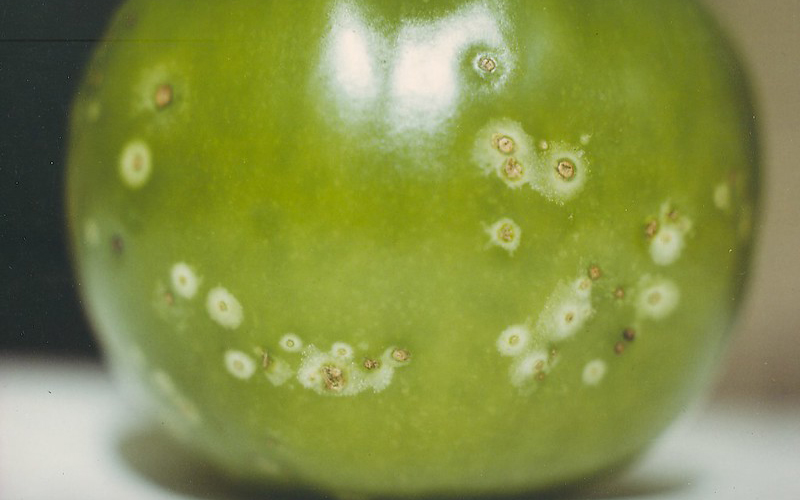Pathogen Profile provides a concise summary of a plant pathogen that growers are interested in. See our Resource page to see what we aim to cover in each post.
What is Clavibacter michiganensis?
Clavibacter michiganensis is a bacterium (belonging to the phylum Actinobacteria) with multiple subspecies that cause disease in tomatoes, potatoes, bell pepper, wheat, alfafa, and beans [1]. One of the more infamous subspecies known for its large economic impact is C. m. subsp. michiganensis which causes bacterial wilt and cankers in tomatoes. We will focus on this subspecies in this post.
Infection and Symptoms
Clavibacter michiganensis subsp. michiganensis can cause various symptoms on tomatoes depending on the life stage of the plant, cultivar, and growing conditions. When seeds or seedlings are infected, plants grow to develop systemic infections that heavily affect the vascular system of the plant thus decreasing the quality and yield of fruit and eventually causing death of the plant [1, 2]. These symptoms include:
- Wilting; commonly wilting on one side of the plant at early stages
- Yellowing and browning of the vascular tissue (seen when you dissect the stem laterally)
- Cankers on stem and petioles
Whereas, older plants tend to develop localized infections which cause leaves to yellow but may not necessarily affect yield and quality of fruit [1, 2]. Symptoms exhibited by older plants include:
- Marginal necrosis of leaves appearing dried and curled
- Spots with whitish halos (“bird’s eyes”) on fruits
Environmental conditions
pH
The pH of the root zone has a considerable influence on the survival and dispersal of C. m. subsp. michiganensis. The recommended pH for nutrient solutions for growing hydroponic tomatoes is 5.5-6.5 [5, 6]. However, maintaining the root zone or the drainage solution at pH 4.0-4.5 overnight can help decrease the survival of C. m. subsp. michiganensis and an overall maintenance of a lower root zone pH of 5.0-5.5 can curb the pathogen’s transmission [4].
Temperature
Optimal temperature for bacterial canker development is between 23-28°C [7]. Pathogenic C. m. subsp. michiganensis has been shown to quickly take hold at around 28°C [7]. In a soil-based study, seedlings grown at a constant temperature of 28°C after C. m. subsp. michiganensis inoculation expressed greater incidences of wilting and dying than those constantly at 15°C or 35°C. However, seedlings grown at a constant temperature of 15°C took longer to increase expression of virulence genes after pathogen inoculation than compared to those constant at 28°C and 35°C. This suggests infection at an early stage of the plant heavily influences symptom development; a constant lower temperature increases incubation time [7].
Dispersal
Infected fruits can give rise to infected seeds (internally) and contaminated soil/substrate in nurseries or propagators contribute to the early transmission of C. m. subsp. michiganensis. Later on, the pathogen also has a greater chance of transmission and causing systemic infections when plants are susceptible to injuries during grafting or transplanting. After transplanting infected seedlings, high populations of C. m. subsp. michiganensis on leaf surfaces (not causing infection) can disperse via wind thus causing secondary or localized infections in other plants depending on environmental conditions and farming practices. Localized infections can be a result of the pathogen entering through wounds or natural openings (stomatas) on the leaves and stems or via water splashes and leaf guttation from adjacent infected plants [2, 3]. C. m. subsp. michiganensis could also move downward from the plant to the roots and then contaminate the substrate and recirculating nutrient solution in a hydroponic system [4].
Practices to control and manage
The Horticultural Development Company in the UK has an excellent technical review that summarizes insights on the disease spread, symptoms, and practises to control and minimize C. m. subsp. michiganensis infections [3].
Here we summarize some of the important points that they mention:
Propagation
- Ensure that seeds have been tested and free of C. m. subsp. michiganensis
- Ensure strict levels of sanitation during grafting
Handling and managing plants
- Avoid or minimize handling plants when they are wet
- Do not wet spray irrigate when C. m. subsp. michiganensis is suspected or confirmed
- Use clean gloves and knife disinfected by heat or an appropriate reagent
Hydroponic system
- Ensure recirculating nutrient solution has been treated
- Reduce the survival and spread of C. m. subsp. michiganensis by reducing pH of root zone to pH 5.0-5.5 at night only if it doesn’t negatively impact the plant [4]
Removing infected plants
- Bag plant in their spot first rather than transporting before containment
- Remove all fallen fruits, leaves, and debris
- Disinfect or replace hydroponic equipment
- Replace slabs that contained infected plants
What do we still need to know?
Infected or contaminated seeds are major sources of C. m. subsp. michiganensis outbreaks thus we need to better disinfect seed surfaces or detect infected seeds. One way to test seeds is to sequence the seed surface and the insides of the seed to detect pathogens. Outside of Healthy Hydroponics, Metagenom Bio Life Science has experience in sampling seeds for contamination for seed propagators.
In addition, understanding the temperature influence on C. m. subsp. michiganensis incubation and development beyond early stages can help curb widespread infection and reduction in yield.
Important Notes
The information we present in Pathogen Profile is based on collating published peer-reviewed scientific literature and sources we think are reliable. This is by no means an exhaustive review of pathogens. Pathogen Profile gives a small glimpse of what is known about pathogens and we encourage growers to do more research on their own based on the pathogens in relation to their own crops and hydroponic systems. We are not plant pathologists thus the information presented in Pathogen Profile should not be used as professional advice to treat pathogens or to operate your hydroponic system.
Photo: Bacterial canker of tomato. Photo courtesy of Scot Nelson (via Flickr)
Works Cited
[1] Nandi, M., Macdonald, J., Liu, P., Weselowski, B., & Yuan, Z. C. (2018). Clavibacter michiganensis ssp. michiganensis: bacterial canker of tomato, molecular interactions and disease management. Mol. Plant Pathol., 19(8), 2036–2050.
[2] de León, L. , Siverio, F. , López, M.M. and Rodríguez, A. (2011). Clavibacter michiganensis subsp. michiganensis, a seedborne tomato pathogen: healthy seeds are still the goal. Plant Dis. 95, 1328–1338.
[3] O’Neil, T. and Mayne, S. (2014). Tomato bacterial wilt and canker Clavibacter michiganensis subsp. Michiganensis (Publication No. TR-PE 002). Horticultural Development Company. https://projectblue.blob.core.windows.net/media/Default/Horticulture/Publications/Technical%20Review%20-%20Tomato%20bacterial%20wilt%20and%20canker.pdf
[4] Huang, R., Tu, J.C. (2001). Effects of nutrient solution pH on the survival and transmission of Clavibacter michiganensis ssp.michiganensis in hydroponically grown tomatoes. Plant Pathol.: 50, 503-508.
[5] Kroggel, M., & Kubota, C. (2018, September 19). Hydroponic Nutrient Solution for Optimized Greenhouse Tomato Production. Ohioline. https://ohioline.osu.edu/factsheet/hyg-1437.
[6] Editorial Staff. (2019, May 12). A Beginners Guide to Growing Tomatoes Hydroponically in Home. Leaffin. https://www.leaffin.com/hydroponic-tomatoes/.
[7] Sharabani, G. et al. (2014). Temperature at the early stages of Clavibacter michiganensis subsp. michiganensis infection affects bacterial canker development and virulence gene expression. Plant Pathol., 63(5), 1119-1129.





